If you’re planning to camp near Walnut Canyon National Monument, you’ll want practical info on where to stay, what to bring, and how to follow rules that protect the canyon. There aren’t campgrounds inside the monument, so you’ll choose nearby sites or dispersed options and prepare for limited services, water, and variable roads. Keep your gear, permits, and safety checklist ready — and keep going to find specific spots, tips, and rules.
Overview of Walnut Canyon National Monument
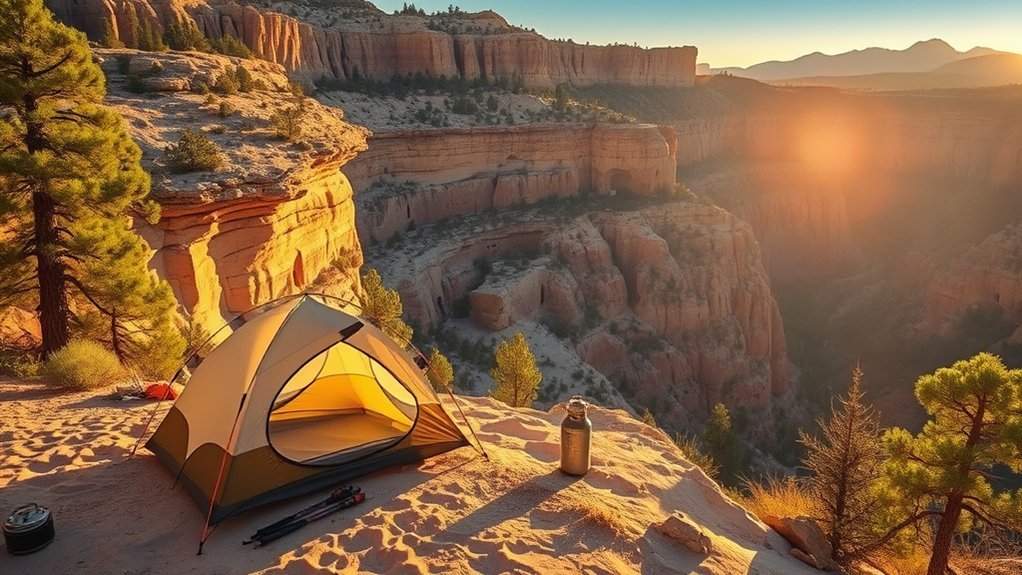
Walnut Canyon National Monument preserves over 2,000 years of human history, spotlighting 232 prehistoric sites—mostly Sinagua cliff dwellings—set along a dramatic inner-canyon rim; you’ll immediately sense the mix of cultural depth and natural beauty. You can follow hiking trails like the Island Trail to reach 25 cliff dwelling rooms and take in canyon vistas without strenuous climbing. The visitor center gives concise exhibits, maps, and context about the Sinagua people and their dry-farming lifeways, which helps you plan a meaningful visit. While the monument isn’t a traditional campground, your camping experience nearby can be enriched by morning canyon walks and interpretive stops. Use the site’s resources to pair outdoor time with responsible cultural appreciation.
Planning Your Visit and Permits
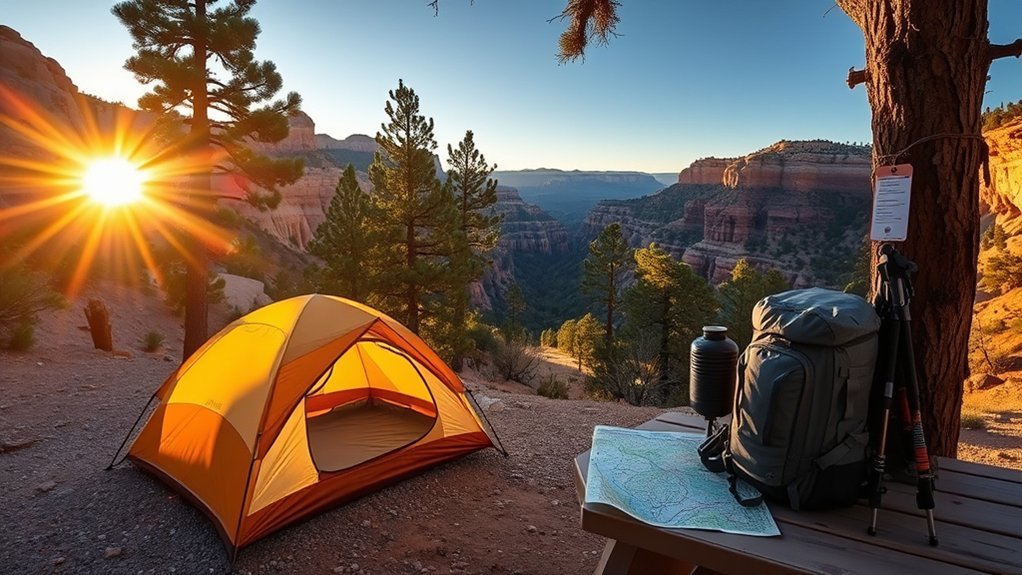
Because the monument is closed through 2025, plan ahead so you don’t travel expecting on-site services or camping; instead, look into nearby Forest Service primitive sites and confirm any required permits with local rangers. When planning, verify current road conditions and any temporary closures or restrictions before you go. Dispersed camping isn’t allowed inside the monument, so follow surrounding land regulations and obtain permits if required for nearby sites. If campfires are permitted, use designated rings, keep them small, and fully extinguish them. Practice Leave No Trace: pack out trash, avoid damaging vegetation, and minimize campsite impact. Contact the local ranger district for up-to-date permits, fire rules, and site-specific guidance to stay compliant and safe.
Campgrounds, Dispersed Sites, and Boondocking Options
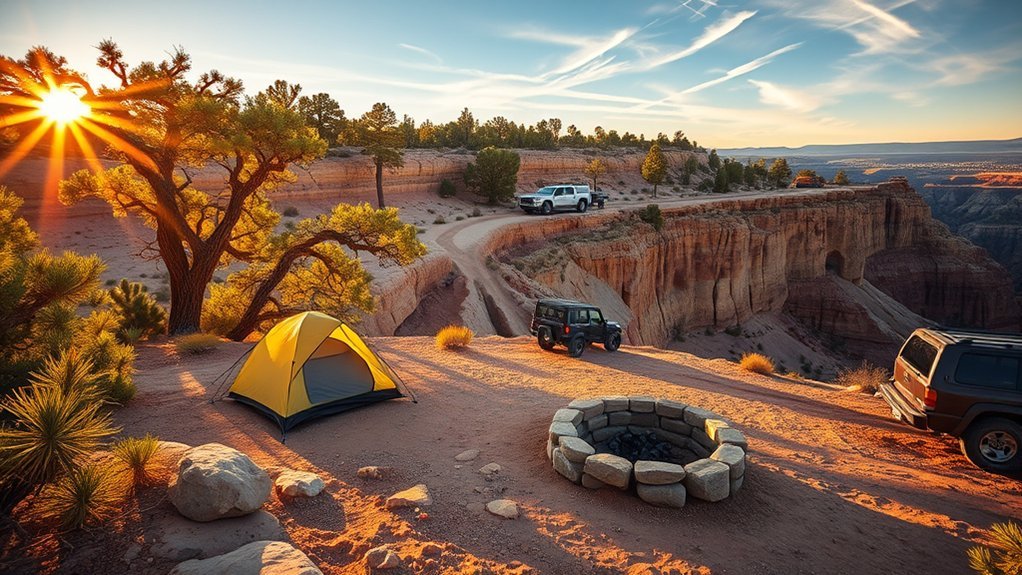
You won’t find official campsites inside Walnut Canyon, but nearby options like Canyon Vista Campground give you more amenities if you want a bit of comfort. If you’re headed for dispersed or boondocking spots on Coconino National Forest land, follow the rules—Walnut Canyon Rd camping is closed until 2025 and primitive sites lack water or hookups. Bring everything you need, use designated fire areas, and pack out all trash to stay within regulations and Leave No Trace.
Official Campgrounds Nearby
If you’re planning to stay near the monument, you won’t find official campgrounds inside the park but you’ll have several nearby choices—from a paid, serviced site at Canyon Vista Campground about 19 miles away to free, primitive dispersed spots along Walnut Canyon Road. You’ll pick by comfort level: Canyon Vista Campground offers amenities for a fee, while the dispersed camping area gives true primitive spots with no services. The Flagstaff area overall has varied camping options and some boondocking for off-grid seekers. Remember to follow rules and regulations for any site you choose and bring water and supplies. Consider Cinder Hill OHV Area 2 if you want primitive camping with off-road access.
- Relief — serviced comfort at Canyon Vista Campground
- Freedom — dispersed camping area serenity
- Grit — rustic boondocking adventure
- Thrill — Cinder Hill OHV primitive access
Dispersed Camping Rules
When planning dispersed camping around Walnut Canyon, follow a few clear Forest Service rules so your trip stays legal and low-impact: stay within 300 feet of a road, camp at least 1/4 mile from water, and limit your stay to 14 days in any 30-day period. You can use dispersed camping in the Coconino National Forest, but remember camping inside Walnut Canyon National Monument is prohibited. Stick to forest roads to find established spots, respect maximum 14 days residency, and check for road closures before you go. Follow Leave No Trace principles — pack out waste and use existing fire rings only if fires are allowed. Be prepared: some routes need high-clearance vehicles and varied terrain skills.
Boondocking Access Tips
Looking for rustic spots or a few more comfortable options around Walnut Canyon? You can try Walnut Canyon dispersed camping or stay at nearby established campgrounds like Canyon Vista Campground. Boondocking locations along Walnut Canyon Road offer true rustic camping experiences, but they lack amenities, so bring water, food, and shelter.
- Expect rough terrain — prioritize planning for off-road driving and a capable vehicle.
- Some dispersed zones are closed until 2025 — check current maps and closures.
- Follow a strict leave-no-trace policy: pack out all trash, human waste, and gear.
- If you want comforts, reserve at established campgrounds rather than risking remote sites.
Be practical, prepared, and respectful to protect the canyon for others.
Water, Supplies, and Essential Gear
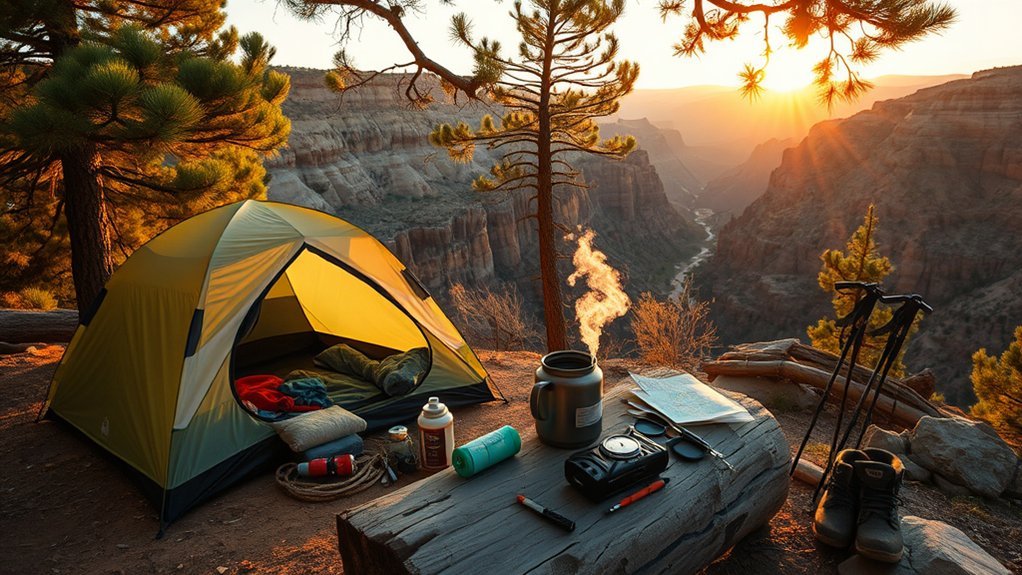
Because Walnut Canyon Rd Dispersed Camping offers no drinking water or services, you should arrive with all the water and supplies you’ll need—plan on about one gallon per person per day for drinking and basic hygiene. Pack food, cooking gear, a reliable stove, and a compact first-aid kit. Bring tent, sleeping bag, pad, and waste‑management tools to follow Leave No Trace. Check the weather before you go and layer clothing with rain gear and warm options for temperature swings. If you’ll venture into the backcountry, carry maps, GPS or a compass and know how to use them; some roads are rough and may need off‑road capability. Organize supplies so essentials are easy to access.
Trails, Hikes, and Things to Do
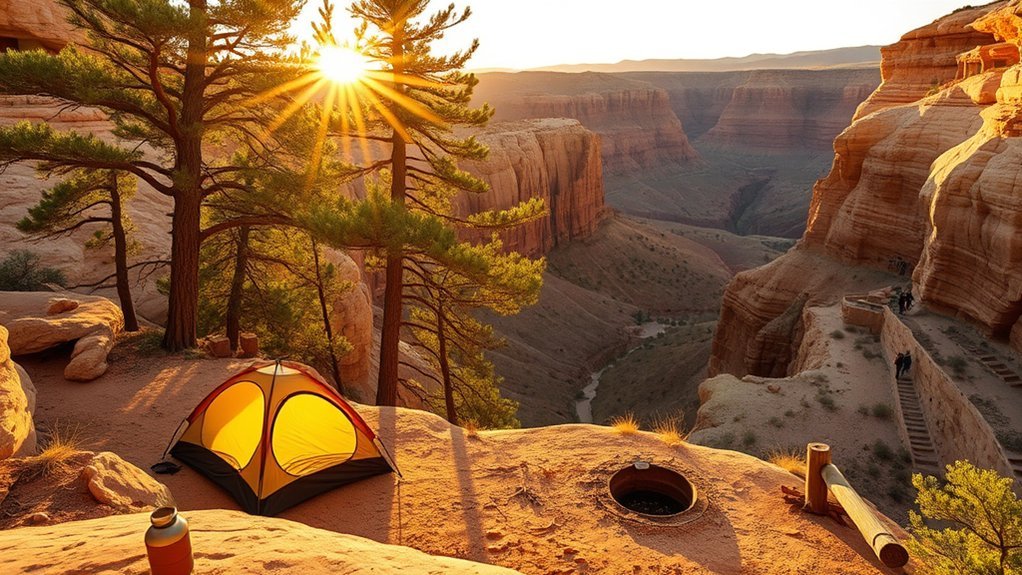
If you want a compact, rewarding hike that mixes history and scenery, Walnut Canyon delivers—start with the Island Trail for the full cliff‑dwelling experience or take the gentler Rim Trail for easy overlooks. You’ll spend about two hours to enjoy the museum, trails, and ruins; families get a strong educational opportunity exploring 25 cliff dwelling rooms and learning Sinagua techniques. Ranger-led programs run seasonally (June–August), deepening context on ecology and culture. Wildlife and bird watching are common, so bring binoculars for better photography and spotting.
- Feel awe descending to ancient rooms.
- Get curious at every interpretive sign.
- Delight in sudden bird calls.
- Capture light on sandstone walls.
Rules, Safety, and Leave No Trace Practices
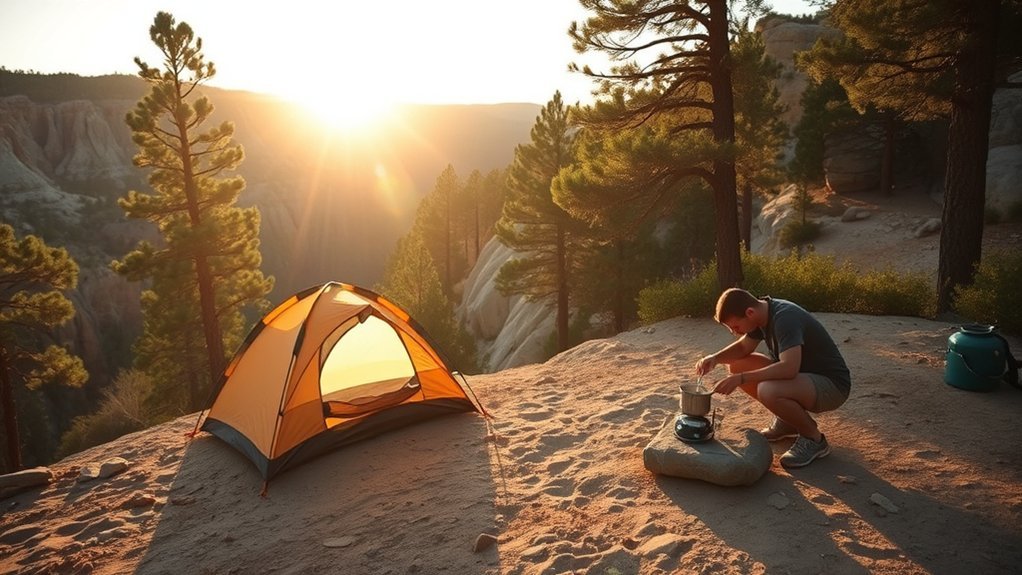
While you can’t camp inside Walnut Canyon National Monument, you can still enjoy nearby dispersed sites—just plan ahead and follow the rules to keep the area safe and pristine. You’ll use dispersed camping and must follow current regulations: check closures, pack sufficient water, and bring supplies because amenities aren’t available. Practice Leave No Trace—pack out trash, minimize campsite impact, and respect wildlife. Fires are allowed only in designated rings where permitted; always fully extinguish them to reduce wildfire risk. For safety, tell someone your plan, carry maps and first-aid, and monitor weather and fire advisories. Stay aware of changing regulations to keep yourself and the canyon’s ecosystems protected.
| What to bring | What to avoid |
|---|---|
| Water & supplies | Leaving trash |
| Fire ring use | Disturbing wildlife |
| First-aid kit | Unattended fires |
| Current regulations | Creating new fire rings |
Access, Road Conditions, and Vehicle Considerations
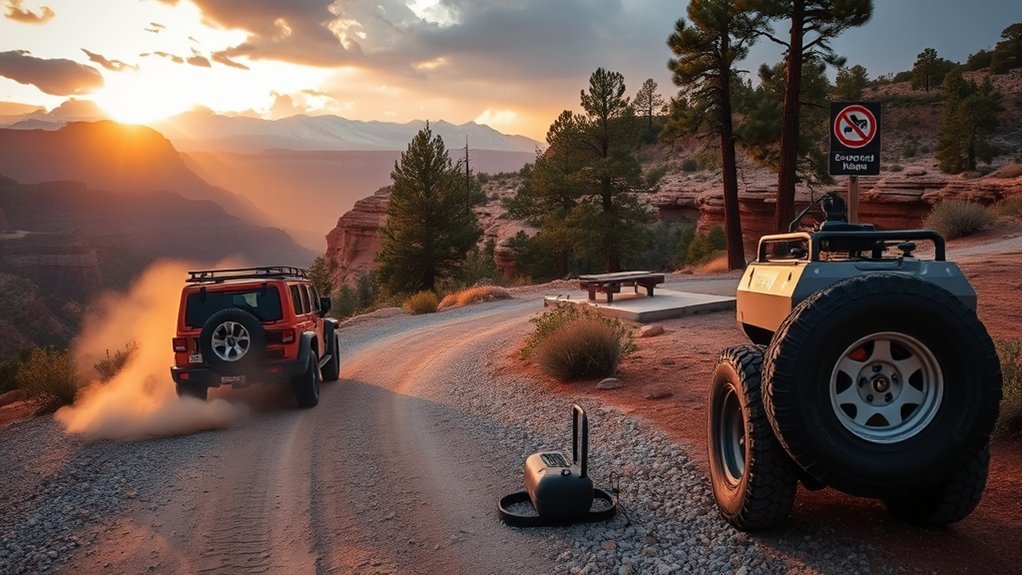
You’ll reach Walnut Canyon from I‑40 Exit 204 and drive about 3 miles south to the visitor center, but roads into dispersed camping areas vary in surface and difficulty. Some routes are packed dirt suitable for most cars, while others can get rough, uneven, or slick after rain or snow and may require high‑clearance or off‑road vehicles. Check current closures and restrictions before you go so you don’t get stuck or try to drive a low‑clearance RV where it won’t fit.
Road Surface and Difficulty
Road surface at Walnut Canyon ranges from packed dirt suitable for most passenger cars to rough, uneven tracks that demand high-clearance or 4WD, especially after rain or snow. You’ll approach from Flagstaff on a mostly firm road, but access to dispersed camping often turns to rutted, unmarked paths. Expect rough terrain that can surprise vehicles, and check seasonal closures before you go. If you plan to explore remote spots, prepare for primitive conditions and limited turnaround space for larger rigs.
- Anticipation: the canyon’s wild access feels exciting but risky.
- Caution: wet conditions quickly make the road treacherous.
- Preparedness: bring recovery gear and maps.
- Respect: leave no trace in fragile dispersed camping areas.
Vehicle Requirements and Clearance
One clear rule: bring a vehicle that matches the conditions — during dry spells a regular passenger car will often do, but after rain or snow you’ll want high clearance or 4WD to handle ruts, washboards, and uneven tracks. You should check recent road conditions before you go and confirm vehicle readiness for rough terrain. The packed dirt access road is usually fine when dry, but some segments need cautious driving. Larger RVs may struggle to reach dispersed sites; smaller campers fare better. Bring recovery gear, air down tires if needed, and avoid risky shortcuts.
| Situation | Recommendation |
|---|---|
| Dry access road | Passenger car okay |
| Wet/muddy | high-clearance or 4WD vehicles |
| Narrow spots | Smaller vehicles preferred |
| Remote sites | Prepare for rough terrain |
Nearby Lodging and Alternative Camping Areas
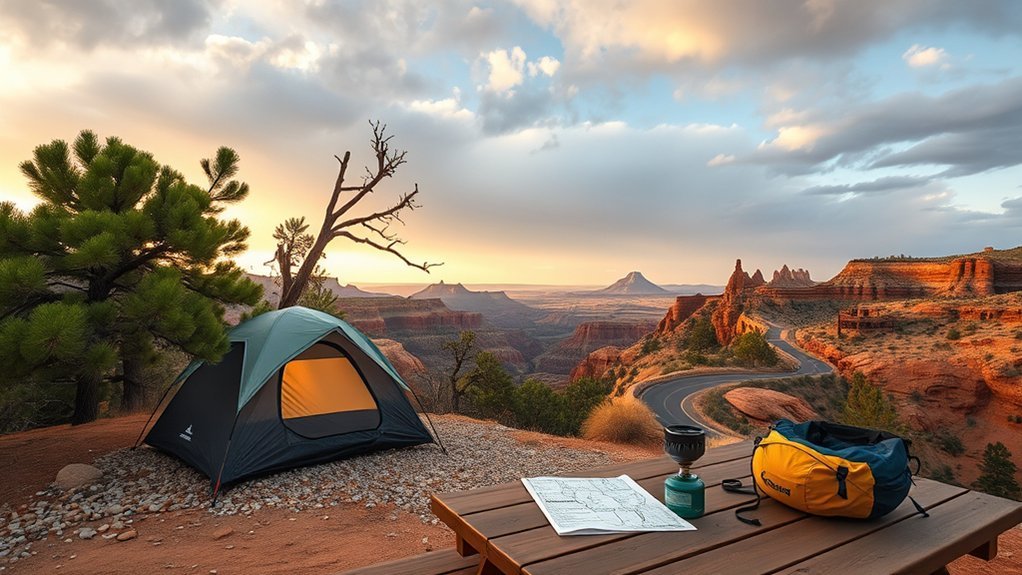
While Walnut Canyon itself doesn’t offer developed camping, nearby options make it easy to find the right setup for your trip—whether you want a comfortable campsite with amenities, a rustic lakeside stay, or true boondocking. You can choose based on comfort level and vehicle capability.
While Walnut Canyon has no developed camping, nearby sites offer everything from serviced sites to rustic lakeside and boondocking options
- Canyon Vista Campground (19 miles) gives you fire rings and picnic tables when you want a serviced campground that still feels outdoorsy.
- Dispersed camping along Walnut Canyon Road offers quiet, natural spots if you don’t need hookups or facilities.
- Marshall Lake in Coconino National Forest provides rustic camping, fishing, and views of the San Francisco Peaks for a peaceful retreat.
- Cinder Hill OHV Area 2 and Flagstaff options like KOA or Fort Tuthill suit primitive camping or family-focused stays with more amenities.
Frequently Asked Questions
Can You Camp at the Walnut Canyon National Monument?
No, you can’t camp inside Walnut Canyon National Monument. Follow camping regulations, consider campsite reservations nearby, pick best seasons, enjoy nearby attractions, expect wildlife encounters, pack essential gear, and heed safety tips for dispersed camping.
What Is the Difference Between Camping and Backcountry Camping?
One’s a backyard festival; the other’s heroic solitude. You’ll car camp, tent camp, or RV camp with facilities, while backcountry uses backpacking techniques, wilderness survival, careful campsite selection and strict outdoor ethics—no trash, minimal impact.
How Much Time Do You Need at the Walnut Canyon National Monument?
You’ll need about a half-day — roughly 2+ hours for the visitor center, hiking trails, archaeological sites, scenic views, wildlife spotting and photography opportunities; plan extra time if you join ranger programs or linger for sunsets.
What Is Secret Camping Called?
Secret camping’s usually called boondocking; you’ll also hear stealth camping, wild camping, dispersed camping, primitive camping, off‑grid camping, and people may refer to secret sites or boondocking sites when describing those remote, low‑impact stays.
Conclusion
Whether you camp at a nearby campground or choose dispersed spots, plan like you’re preparing for a day in the desert: thorough and intentional. Bring ample water, sturdy footwear, navigation tools, and weather-appropriate layers. Respect park rules, practice Leave No Trace, and check road conditions so your vehicle won’t strand you. With sensible preparation, you’ll enjoy Walnut Canyon’s trails and vistas safely and leave the landscape as pristine as you found it.

